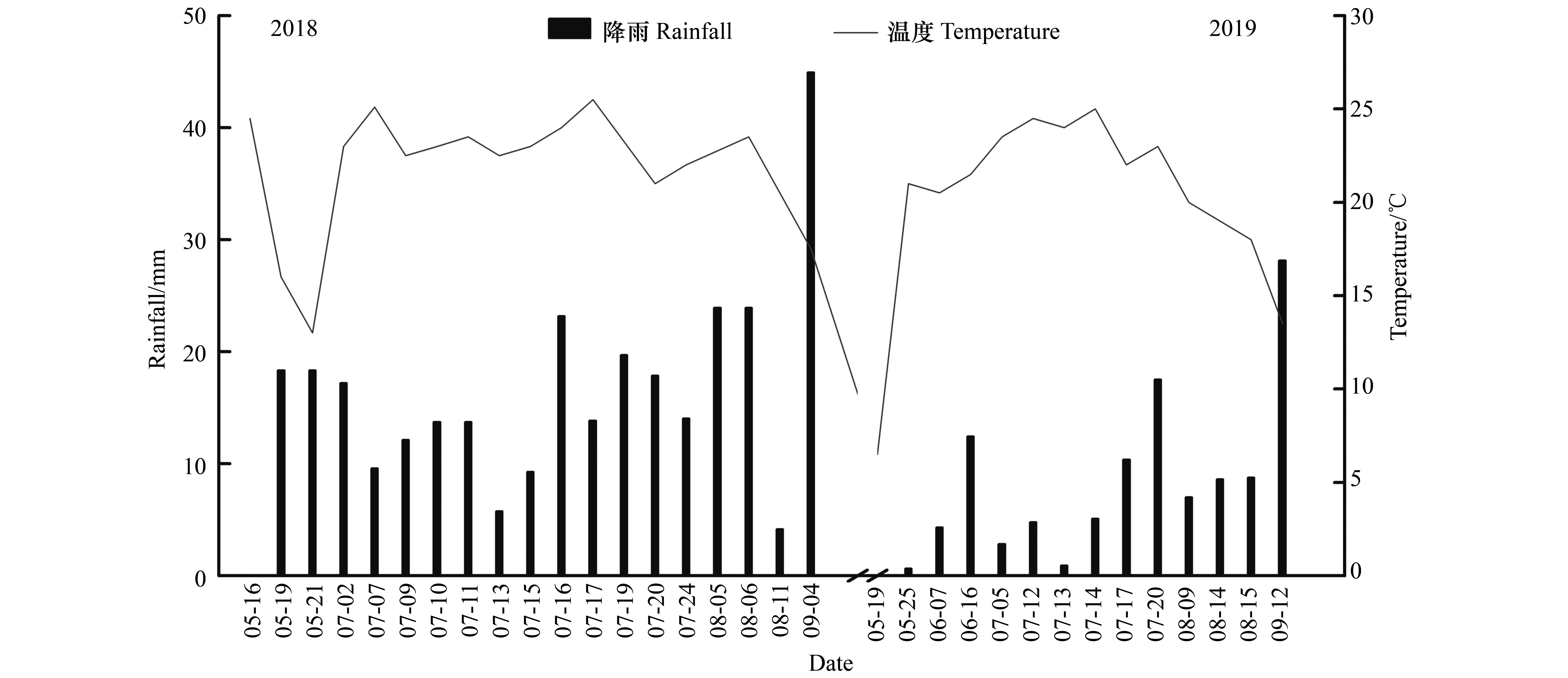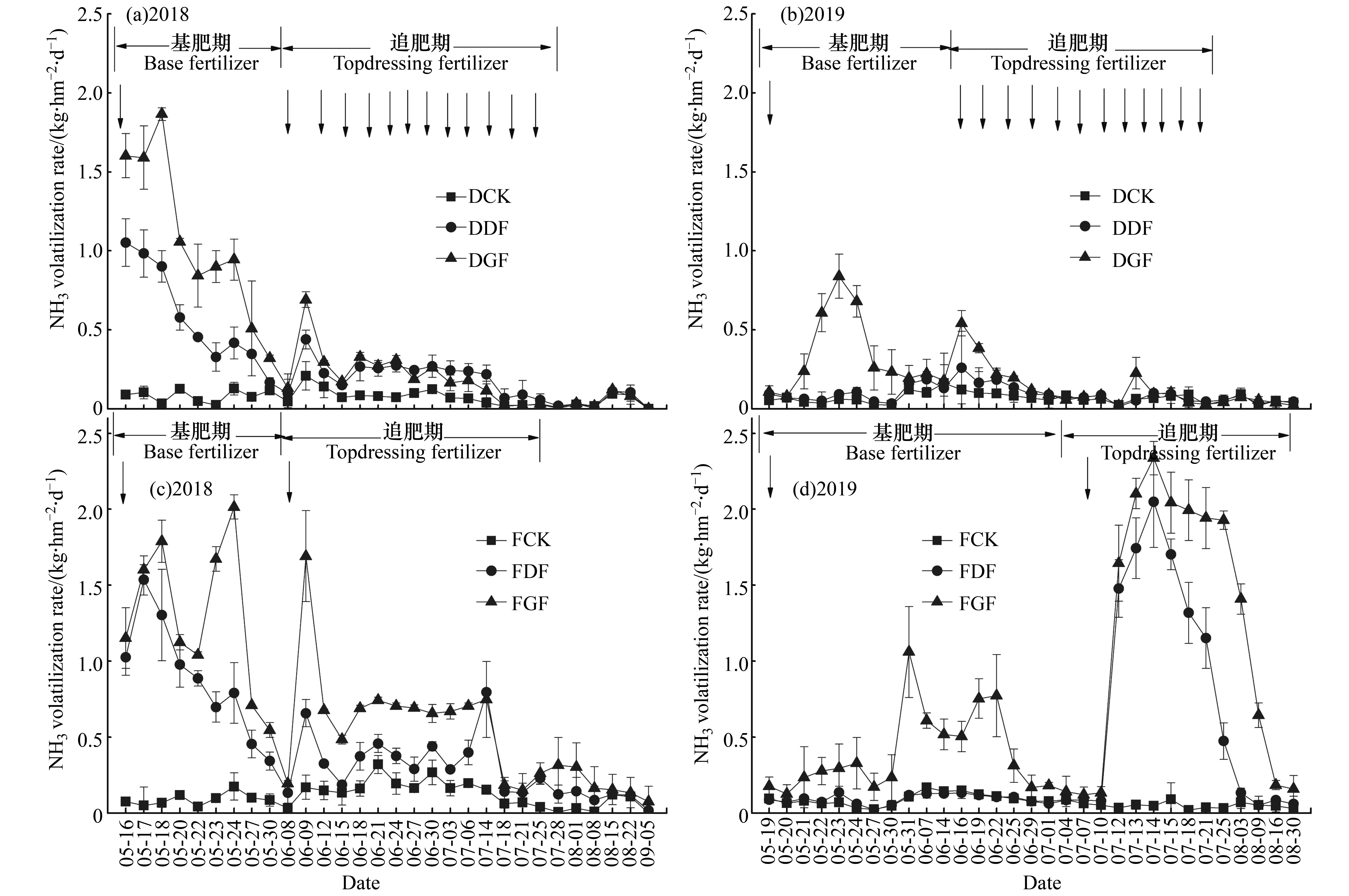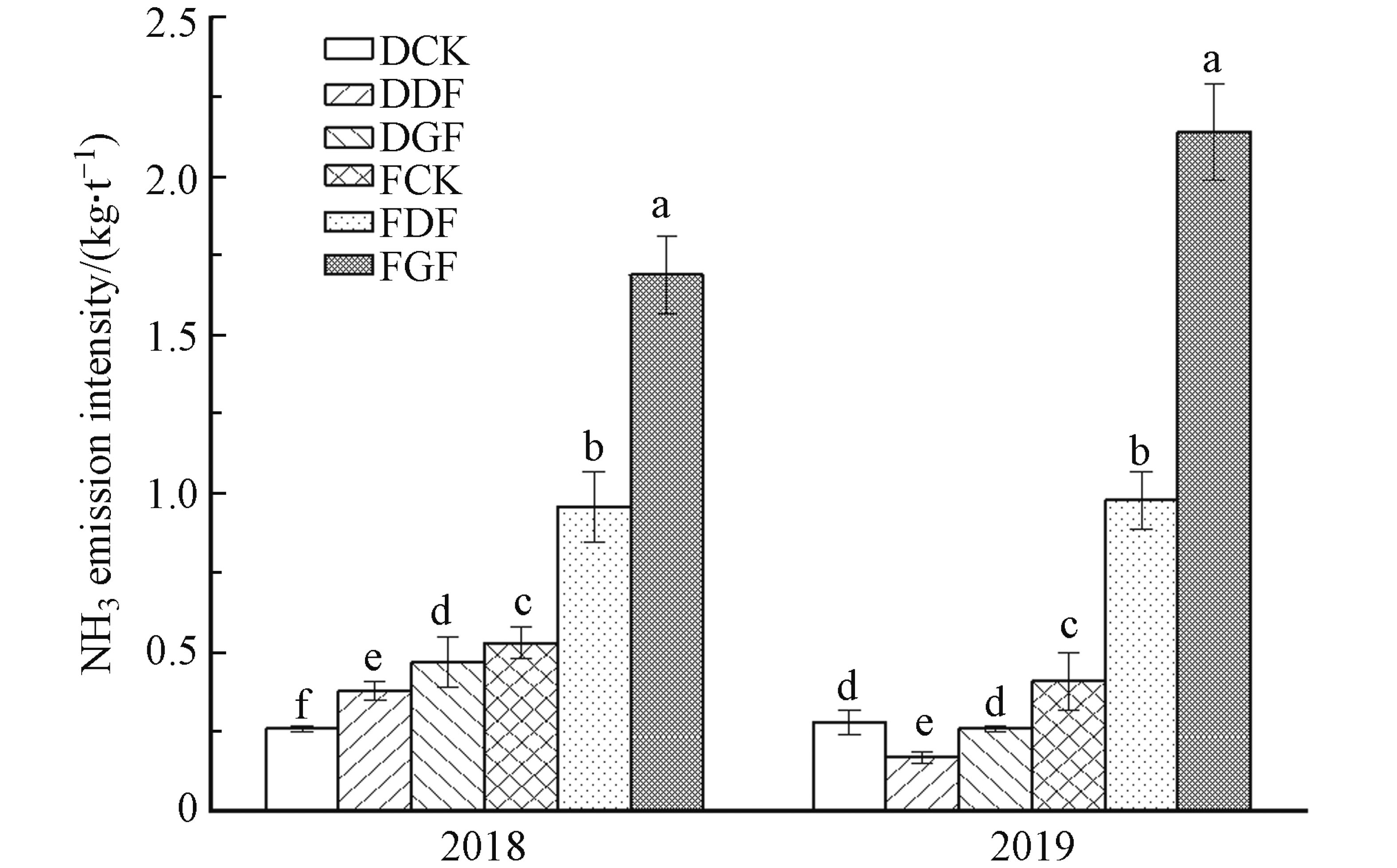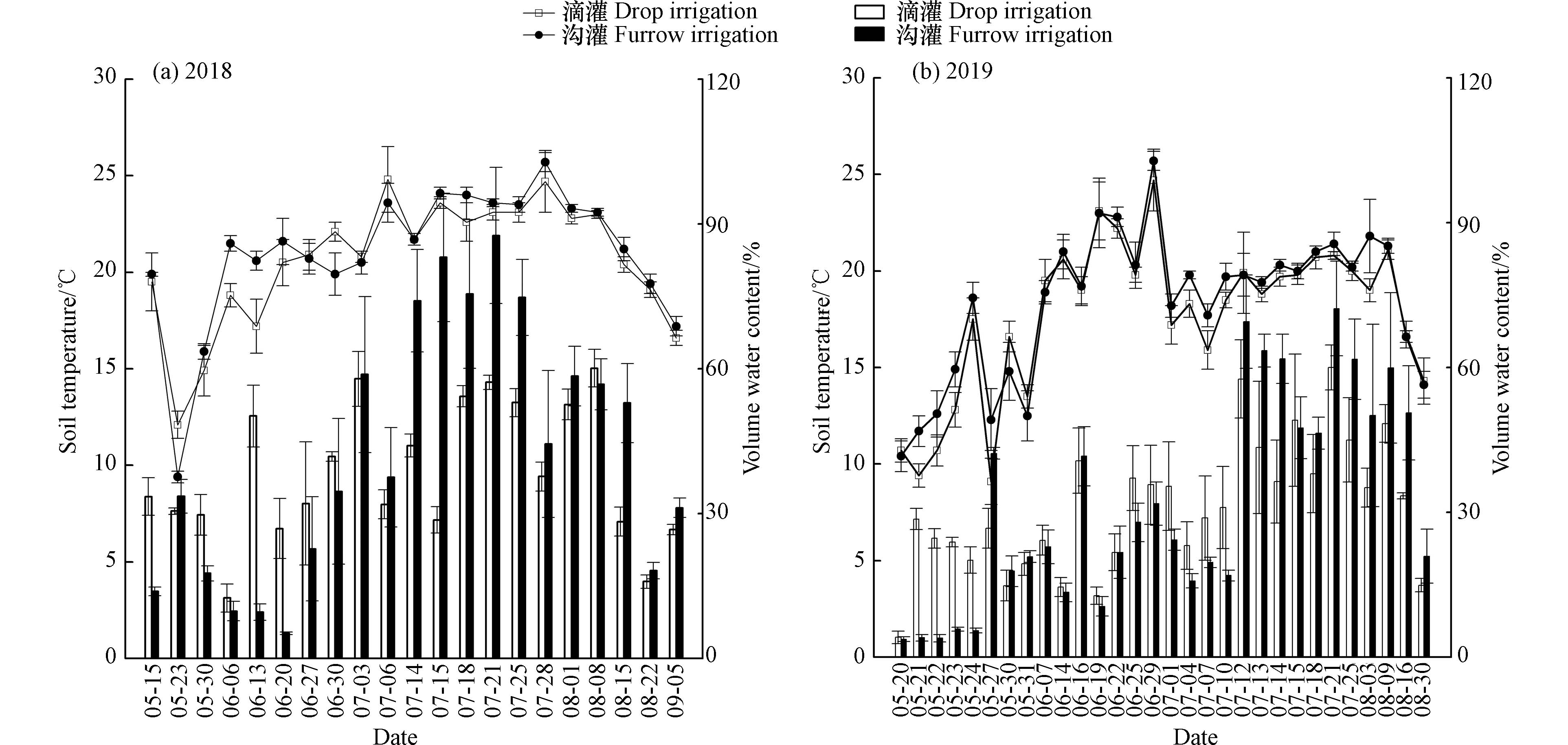-
氨(NH3)挥发是农田生态系统化肥氮损失的重要途径[1],占农业源NH3排放的40%[2]. NH3挥发不仅降低氮肥利用率,造成资源浪费,而且挥发到大气中,通过干湿沉降再次回到地表,引发土壤酸化、地表水富营养化、地下水污染及空气质量退化等环境问题[3-5].
水肥管理是影响土壤NH3挥发的重要因素,然而,当前研究较多集中于稻田和典型旱地作物系统如玉米、小麦、黄瓜、棉田和番茄等常规施肥传统沟灌、减量控制沟灌试验处理上[6-9].滴灌和沟灌不同施肥灌溉模式比较研究资料甚少,且研究结果具有很大不一致性. 一些观测结果显示,常规施肥滴灌农田NH3挥发量低于传统沟灌农田NH3排放量. 例如:马腾飞等[10]利用室内土柱模拟实验研究表明,不同施肥处理沟灌土壤NH3挥发量高于滴灌土壤. 王娟等[11]模拟土柱实验测定滴灌土壤氮流失量比传统沟灌土壤少7.16%. 然而,有的研究结果显示滴灌农田土壤NH3排放量比传统沟灌农田土壤排放高. 王肖娟等[12]研究不同施氮量滴灌土壤NH3-N排放损失量0.06%—0.14%,高于沟灌土壤.
综合现有资料发现,不同环境条件NH3排放研究已经取得一些成果. 然而,农田土壤NH3排放具有明显时空变异性,我国幅员辽阔,土壤、作物和气候类型多样,区域经济发展不平衡导致农田NH3排放有明显地域性差异[13],限制了不同生产模式农田NH3排放总量科学估算,很难评估更大尺度、更长时间NH3排放趋势,这已成为农田NH3排放总量估算不确定性因素[14].
内蒙古地处干旱半干旱区,是我国马铃薯最大主产地[15]. 生产过程不合理灌溉和过量氮肥施用,增加了水肥损失,加重了环境污染风险[16-17]. 我国西北干旱半干旱区节水灌溉面积不断增加,本文以滴灌水肥一体化和传统沟灌马铃薯田为研究对象,通过对NH3挥发通量原位观测比较,了解不同施肥灌溉模式马铃薯田土壤NH3挥发过程和特征影响规律,评估不同施肥灌溉模式土壤NH3挥发强度,为构建干旱半干旱区不同施肥灌溉模式马铃薯田生产和NH3减排双赢的农业生产体系提供数据支撑.
-
试验于2018—2019年5—9月在内蒙古呼和浩特市郊区马铃薯试验基地(40°45′34″N,111°41′56″E,海拔1045.4 m)进行. 该地区属中温带大陆性季风气候,年平均气温6.7 ℃,年蒸发量2000 mm左右,平均日照时数多于2629.8 h,无霜期134 d. 多年平均降水量 335.2—534.6 mm,主要集中在每年7—8月. 灌溉水源为地下水,符合灌溉水质标准. 供试土壤为栗钙土,容重1.40 kg·m−3,有机质3.89%,土壤孔隙度42.63%,相对密度2.53%, 铵态氮30.69 mg·kg−1, 硝态氮53.71 mg·kg−1,pH8.42.
-
供试作物选择“克新一号”脱毒原种马铃薯,每年 5 月中旬播种,9月中旬收获.试验采用随机区组设计,设置滴灌施肥500 kg·hm−2 (DDF)、滴灌施肥1000 kg·hm−2 (DGF)、滴灌不施肥 (DCK)、沟灌施肥500 kg·hm−2 (FDF)、沟灌施肥 1000 kg·hm−2 (FGF) 、沟灌不施肥 (FCK),共6个处理,每个处理重复3 次,每个处理间设置隔离带1 m. 其中,500 kg·hm−2施氮量为当地常规施肥量.
每个处理小区为1 个施肥灌溉单元. 每个处理种植8 垄,垄长11.2 m,垄高30 cm,垄间距90 cm,马铃薯株距20 cm. 滴灌水肥一体化处理由一套首部系统控制,包括球阀、水表、压力表、闸阀、筛网式过滤器、压差式施肥罐. 每垄布置一条滴灌带,滴头间距30 cm,滴头流量 1.38 L·h−1,工作压力 0.1 MPa. 播种后当日首次灌水,灌水定额 40 mm,苗期至淀粉积累期每3天灌溉1次,每次灌水量5 mm,全生育期灌溉总量100 mm. 传统沟灌处理应用带水表的水管灌溉,以水至垄顶为准,播种后当日第一次灌水140 mm,块茎形成期灌水140 mm. 播种基肥:马铃薯专用肥(N-P-K,12∶19∶16);追肥:硝酸钾和尿素,滴灌水肥一体化模式从苗期到淀粉积累期,随灌溉水分次追施;传统沟灌模式与当地农业生产管理措施一致,将肥料撒施于垄顶表面,在块茎形成期一次性追施.
-
采用通气法[4]进行土壤NH3挥发原位监测. NH3捕获装置由内径15 cm,高15 cm两面敞开的有机玻璃圆管制成,管内带有上下两层固定支架,分别放置一块浸以30 mL 0.005 mol·L−1 硫酸溶液的海绵(直径15 cm,厚2 cm),下层海绵距地面5 cm,用于吸收土壤挥发的NH3,上层海绵用于隔离外界空气的NH3和灰尘进入. 捕获装置顶部管口设置3 根5 cm高支撑架,放置直径17 cm遮雨板,保障阴雨天正常采集样品,同时保持空气流通.
早上8:00—9:00采集气体样品. 施肥后1周内,每天取1次样. 一周后,每3 天取1次样,后期依据NH3挥发速率情况, 1周取1—2次样,直至NH3挥发速率和对照接近为止.取样时,迅速将下层海绵放入装有100 mL 1 mol·L−1 KCl溶液的采样盒(直径15 cm)中,用手挤压海绵使其完全浸入KCl 中,立即密封,同时,换上另一块浸过硫酸溶液的海绵. 上层海绵视其干湿情况,每隔1—3天 更换1次. 采集气体时,同时测定土壤温度、水分. 采集的气样带回实验室,振荡1 h,提取,用靛酚蓝比色法测定NH3含量.
-
土壤NH3挥发速率:
式中,F为NH3-N挥发速率, kg·hm−2 ·d−1;M为单个装置每次NH3-N挥发通量, mg;A 为捕获装置的截面积, m2;D 为每次连续收集的时间, d.
土壤NH3累积挥发量:
式中,S为土壤NH3-N累积挥发量, kg·hm−2;n表示施肥后测定的次数;Ti 表示第i 次测定施肥后的时间, d; Vi为第i 次测定时NH3-N挥发速率, kg·hm−2·d-1.
土壤NH3挥发损失率:
式中,W为土壤NH3-N挥发损失率, %; S1为施氮处理NH3-N累积挥发量, kg·hm−2;S0为不施氮处理氨NH3-N累积挥发量, kg·hm−2;N为施氮量, kg·hm−2.
土壤NH3挥发强度:
式中,P为土壤NH3-N挥发强度, kg·t−1;S表示单位面积NH3-N累积挥发量, kg·hm−2;G表示单位面积作物产量, t·hm−2.
-
采集NH3捕获装置附近0—20 cm 耕层土壤,去除石砾、植物残体和土壤动物,装入自封采样袋,带回实验室避光风干,磨碎,过2 mm 筛,用于土壤理化特性测定. 土壤 pH 值采用便携式pH仪测定,水土比为 2.5∶1;土壤容重采用环刀法测定[17];土壤相对密度采用比重瓶法测定[18];土壤有机碳(SOC)采用重铬酸钾氧化−外加热法测定[19];土壤NH4+-N和NO3 −-N采用流动分析仪测定(2 mol·L−1 的 KC1 浸提,水土比 10∶1).
-
采用 Excel 2014 进行数据处理,SPSS 17.0 软件进行差异显著性检验和相关性分析,应用Origin Pro 2018 软件制图.
-
2018—2019 年,作物生长季气温和降水量变化(图1),气温变化范围分别为13—25.5 ℃和 6.5—25 ℃,最高值均出现在7月份. 两年内降水量变化范围分别为 4.14—47.77 mm 和0.64—28.12 mm, 2018年降水量高于2019年,主要集中在每年的7、8月份.
-
2018年和2019年,滴灌水肥一体化模式NH3挥发速率显著低于沟灌模式[10],两种施肥灌溉模式NH3挥发速率均随施氮量增加而增大(图2). 试验中,6种处理土壤NH3排放速率季节变化规律为施肥灌水后出现吸收高峰(图2),这与杨洁等[4]研究一致. 两种施肥灌溉模式马铃薯田基肥期NH3挥发主要发生在施肥后2周内,追肥期NH3挥发主要发生在追肥后1个月内. 2018年, DDF、DGF滴灌处理NH3挥发速率的最大值分别为1.05 kg·hm−2 ·d−1、1.87 kg·hm-2 ·d-1;而FDF、FGF沟灌处理NH3挥发速率最大值分别为1.54 kg·hm−2 ·d−1、2.02 kg·hm−2 ·d−1 (图2 a和c). 2019年,滴灌水肥一体化DDF、DGF处理NH3挥发速率最大值分别为0.26 kg·hm-2·d−1、0.84 kg·hm−2·d−1,而沟灌FDF、FGF处理 NH3挥发速率最大值分别为2.05 kg·hm−2·d−1、2.34 kg·hm−2·d−1 (图2 b和d). 2018年, DCK和FCK处理NH3挥发速率分别为0—0.21 kg·hm−2·d−1、0—0.27 kg·hm−2·d−1; 2019年分别为0.02—0.16 kg·hm−2·d−1、 0.02—0.15 kg·hm−2·d−1,对照组间挥发速率变化无明显差异(P>0.05).
-
2018年和2019年,不同施肥灌溉处理马铃薯田土壤NH3累积挥发量具有显著差异(P<0.05),同种施肥灌溉模式NH3累积挥发量随施氮量的增加而增加(表1). 2018年滴灌土壤DGF、DDF和DCK处理NH3累积挥发量分别为28.14、21.50、7.20 kg·hm−2, 2019年NH3 累 积 挥 发 量分别为15.25、9.42、7.24 kg·hm−2;2018年沟灌土壤FGF、FDF和FCK 处理NH3累积挥发量分别为66.25、37.06、11.88 kg·hm−2, 2019年分别为76.81、34.73、8.56 kg·hm−2. 2018年,滴灌土壤DGF、DDF和DCK比FGF、FDF和FCK相比分别降低了57.52%、41.99%、38.41%, 2019年,分别降低80.15%、72.88%和15.42%.滴灌土壤NH3累积挥发量小于相同施氮水平的沟灌模式(P<0.01). 2018年,滴灌DGF处理NH3累积挥发量比DDF处理提高31%, 2019年,提高62%; 2018年,沟灌FGF处理NH3累积挥发量比FDF处理增加79%, 2019年,增加121%.
不同灌溉模式土壤结构和理化性质不尽相同,土壤水肥运移和土壤特性影响NH3挥发速率及进程[4,20]. 滴灌水肥一体化技术将肥料溶于水中,肥随水一起输送到作物根区,能够保证水肥适时适量供给作物吸收,土壤通气性好,硝化作用增强,利于作物吸收利用养分,氮肥利用率高,从而降低NH3挥发[21-22]. 与吴腾超等[21]、王肖娟等[22]等的研究结果一致,本研究中同等施氮量下,滴灌模式NH3累积挥发量均小于沟灌NH3累积挥发量. 由表1可知,滴灌方式下马铃薯产量明显高于沟灌,但同一灌溉方式下施氮量翻倍后产量无明显增加,说明过量施肥作物增产不明显. 因此和传统沟灌相比,滴灌低肥的水肥一体化技术的DDF处理增加产量,降低NH3挥发效果最好.
-
同种施肥灌溉模式,随着施肥量增加, NH3净挥发量增加. 2018年和2019年,滴灌DGF处理NH3净挥发量比DDF处理增加46%和2.67倍;沟灌FGF处理比FDF处理增加1.16倍和1.61倍(表1). 不同施肥水平沟灌模式NH3挥发损失率均高于滴灌模式. 2018年,滴灌DDF和DGF处理NH3挥发损失率分别为2.86%和2.09%,沟灌FDF和FGF处理分别为5.04%和5.44%; 2019年,滴灌DDF和DGF处理NH3挥发损失率分别为0.44%和0.80%,沟灌FDF和FGF处理分别为5.23%和6.83%. 2018和2019年,沟灌FDF处理NH3挥发损失率分别是滴灌DDF处理的1.76倍和11.89倍;沟灌FGF处理分别是滴灌DGF处理的2.60倍和8.54倍. 与传统沟灌比较,滴灌水肥一体化模式土壤显著减少NH3挥发损失率.
综上所述,灌溉方式不同,NH3挥发损失率不同。卢艳艳等[23]玉米田施用普通尿素研究得出NH3挥发损失率为6.09%—6.11%;王珏等[24]在河北潮褐土上研究发现麦季NH3挥发损失率为1%—4.2%;马腾飞等[10]棉田研究表明在控制条件下NH3挥发损失率为0.39%,且漫灌NH3挥发损失量高于滴灌.与这些研究结果相似,本研究中土壤,NH3挥发损失率在0.44%—6.83%之间,其中滴灌方式下NH3挥发损失率为0.44%—2.86%,沟灌方式下NH3挥发损失率为5.04%—6.83%,表明本研究两种灌溉的NH3挥发损失率处于正常水平,滴灌下NH3挥发损失率处于较小水平.
-
表2不同灌溉方式和施氮量对农田土壤NH3挥发影响双因素方差分析结果表明,不同灌溉方式、不同施氮量以及灌溉方式和施氮量的交互作用均对土壤NH3挥发影响具有极显著差异(P<0.01).
同一施肥灌溉模式,马铃薯田施肥量增加,NH3挥发强度增强.不同施肥灌溉模式NH3挥发强度存在显著差异(P<0.05),沟灌马铃薯田土壤NH3挥发强度均强于滴灌模式(图3). 2018年,滴灌DDF、DGF和DCK处理NH3挥发强度分别为0.37、0.47 、0.26 kg·t−1;2019年,分别为0.17、0.26、0.28 kg·t−1. 2018年沟灌FDF、FGF和FCK 处理NH3挥发强度分别为0.96、1.69、0.53 kg·t−1, 2019年分别为0.98、2.14、0.41 kg·t−1. 2018年,沟灌模式NH3挥发放强度比滴灌增强103.85%—259.57%,2019年增强46.43%—723.08%. 同一灌溉模式不同施肥水平土壤NH3挥发强度显示,2018和2019年,滴灌DGF处理比DDF分别增强27.03 %和52.94 %;沟灌FGF处理比FDF分别增强76.04%和118.37%. 施肥量增加,沟灌模式土壤NH3挥发强度增加量高于滴灌处理增加量.
-
2018年和2019 年作物生长季,滴灌和沟灌模式土壤温度变化均表现为先升高后降低(图4). 2018年,滴灌和沟灌模式土壤温度峰值均出现在 7 月,分别为24.8 ℃ 和 25.7 ℃; 2019 年土壤温度峰值均出现在 6 月末,分别为 24.7 ℃和 25.7℃.滴灌模式土壤温度均低于沟灌模式.
作物生长季,滴灌和沟灌模式土壤体积含水量波动较大(图4). 2018年,滴灌土壤体积含水量峰值为44.4%,出现在8月初;沟灌峰值为87.6%,出现在 7 月下旬. 两种施肥灌溉模式7月份土壤体积含水量均值高于其他月份. 2019 年,滴灌和沟灌模式土壤体积含水量峰值分别为60.0%和72.2%,均出现在 7 月下旬. 两种施肥灌溉模式土壤体积含水量7月中旬到8月中旬高于其他时期. 沟灌模式土壤体积含水量均值高于滴灌模式. 土壤NH3挥发速率与土壤体积含水量呈极显著相关(P<0.01)(表3). 两年追肥期,由于追肥1周内有降雨(图1),2019年土壤含水量高于2018年同期(图4),2019年追肥期NH3挥发峰值高于2018年. 研究显示,追肥灌水后,土壤含水量增加,土壤NH4+-N含量升高,不能及时被作物吸收,NH3挥发速率迅速增加. MCGaRRY等[25]研究表明,施用氮肥后,土壤含水量高是导致NH3挥发损失的一个重要因素.SHAN等 [26]研究也表明,白菜田沟灌施肥后灌溉通过增加土壤含水量促进尿素水解,导致表土NH4+-N迅速增加,促进NH3挥发.
-
氮肥施入土壤,氮素以NH4+-N 和 NO3− -N 形式供作物吸收[27-28].作物生长季,不同施肥灌溉模式土壤NH4+-N、NO3−-N变化趋势一致,均随施氮量增加而增多. 2018年,滴灌模式土壤NH4+-N、NO3−-N 浓度变化范围分别为22.41—38.91 mg·kg−1、13.38—729.95 mg·kg−1,沟灌模式分别为24.83—145.78 mg·kg−1、6.9—933.40 mg·kg−1;2019年,滴灌模式土壤NH4+-N、NO3−-N浓度变化范围分别为13.65—55.51 mg·kg−1、6.9—93.36 mg·kg−1,沟灌模式分别为20.62—113.66 mg·kg−1、20.82—926.33 mg·kg−1(图5). 相关分析显示,NH3挥发速率和NH4+-N和NO3−-N 浓度均呈极显著相关(P<0.01)(表3), NH4+-N、NO3− -N、NH3挥发速率和施肥量呈极显著相关(P<0.01), 同一施肥水平,滴灌水肥一体化处理土壤NH4+-N 和 NO3−-N低于沟灌处理,因而,滴灌NH3挥发少于传统沟灌[12,29-30]. ,与YANG等[31] 和周广威等[32]研究结果一致. YANG等[31]发现土壤NH4+-N浓度是影响稻田土壤NH3排放的重要因素,土壤NH4+-N浓度对麦田土壤NH3排放的贡献也显著. 周广威等[32]研究表明,随着施氮量增加,NH4+-N 和 NO3−-N 都显著增加,NH3挥发速率与施氮量呈正相关关系.
-
不同施肥灌溉模式影响马铃薯田土壤NH3挥发.同种灌溉模式土壤NH3累积挥发量随施氮量增加而增多. 施氮量、土壤体积含水量、NH4+-N和NO3−-N 浓度显著影响土壤NH3挥发. 与沟灌模式相比,滴灌少肥的水肥一体化显著降低土壤NH3挥发,其中DDF处理效果最佳.我国西北干旱半干旱区马铃薯田推广应用滴灌水肥一体化技术可以有效降低 NH3挥发损失率,减轻NH3挥发强度,提高马铃薯水肥利用效率,降低环境污染.
我国半干旱区滴灌水肥一体化马铃薯田土壤NH3挥发特征和强度及影响因素
Characteristics and intensity of soil ammonia volatilization and study on influencing factors in potato fields under drip integration water and fertilizer integration in semi-arid region of China
-
摘要: 氨(NH3)挥发是农业生态系统氮肥损失的重要途经,然而,北方干旱半干旱地区水肥耦合马铃薯田土壤NH3挥发规律缺少数据支撑. 该研究利用通气法田间原位观测我国西北滴灌水肥一体化和传统沟灌施肥马铃薯田水肥耦合土壤NH3挥发特征,设置滴灌施肥500 kg·hm−2(DDF)、滴灌施肥1000 kg·hm−2(DGF)、滴灌不施肥(DCK)、沟灌施肥500 kg·hm−2(FDF) 、沟灌施肥1000 kg·hm−2(FGF)、沟灌不施肥(FCK) 6个处理. 结果表明,NH3挥发速率峰值出现在施用氮肥后1—2周,不同水肥处理土壤NH3挥发存在显著差异(P<0.01). 2018年DDF、DGF、DCK、FDF、FGF 、FCK土壤NH3累积挥发量分别为21.50、28.14、7.20、37.06、66.25 、11.88 kg·hm−2;2019年,分别为9.42、15.25、7.24、34.73、76.81、8.56 kg·hm−2. 2018年和2019年,沟灌FDF处理的NH3挥发损失率分别是滴灌DDF处理的1.76倍和11.89倍;沟灌FGF处理分别是滴灌DGF的2.60倍和8.54倍. 滴灌DGF处理NH3挥发强度比滴灌DDF处理分别增加27.03%和52.94%,沟灌FGF处理比沟灌FDF处理分别增加76.04%和118.37%. 随施肥量增加,传统沟灌马铃薯田土壤NH3挥发损失率和NH3挥发强度的增量高于滴灌水肥一体化模式. NH3挥发速率与土壤体积含水量、
${{\rm{NH}}_4^{+} }$ -N和${{\rm{NO}}_3^{-}} $ -N呈极显著相关(P<0.01). 和传统沟灌比较,滴灌水肥一体化技术降低马铃薯田土壤NH3挥发损失率,减轻NH3挥发强度,提高马铃薯水肥利用率,减轻环境污染.Abstract: Ammonia (NH3) volatilization is an important way of nitrogen loss in agricultural ecosystem. However, there is a lack of data to support the rule of NH3 volatilization in the soil of water and fertilizer coupled potato field in arid and semi-arid areas of Northern China. In this study, aeration method was used to observe the NH3 volatilization characteristics from the soil of potato fields with water and fertilizer coupling in drip fertigation and connvention furrow irrigation in Northwest China. Six experimental conditions were designed, including drip fertigation 500 kg·hm−2(DDF), drip fertigation 1000 kg·hm−2(DGF), drip irrigation without fertilization (DCK), furrow irrigation and fertilition 500 kg·hm−2(FDF), furrow irrigation and fertilition 1000 kg·hm−2(FGF), furrow irrigation without fertilization (FCK). The results showed that the peak value of ammonia volatilization rate appeared in 1—2 weeks after nitrogen fertilizer application, and there were significant differences in NH3 volatilization among different water and fertilizer treatments(P<0.01) ;In 2018, the cumulative NH3 volatilization amounts in DDF, DGF, DCK, FDF, FGF and FCK soils were 21.50, 28.14, 7.20, 37.06, 66.25 , 11.88 kg·hm−2, respectively. And in 2019, they were 9.42 , 15.25, 7.24 , 34.73 , 76.81, 8.56 kg·hm−2, respectively. The NH3 volatilization loss rate of furrow irrigation with FDF treatment was 1.76 times in 2018 and 11.89 times in 2019 that of drip fertigation with DDF treatment, and that of ffurrow irrigation with FGF treatment was 2.60 times in 2018 and 8.54 times in 2019 that of drip fertigation with DGF treatment. The NH3 volatilization intensity of drip fertigation with DGF treatment increased by 27.03% in 2018 and 52.94% in 2019 compared with drip fertigation with DDF treatment, that of furrow irrigation with FGF treatment increased by 76.04% in 2018 and 118.37% in 2019 compared with furrow irrigation with FDF treatment. With the increase of fertilizer amount, the increases of soil NH3 volatilization loss rate and NH3 volatilization intensity in potato field of traditional furrow irrigation is higher than those in the integrated mode of drip fertigation.The volatilization rate of ammonia was significantly correlated with soil volumetric water content,${\rm{NH}}_4^{+} $ -N and${\rm{NO}}_3^{-} $ -N concentration (P<0.01). Compared with traditional furrow irrigation, drip fertigation with water and fertilizer integration technology can reduce the rate of NH3 volatilization loss, reduce the intensity of NH3 volatilization, improve utilization rate of water and fertilizer in potato field, and reduce the environmental pollution. -

-
表 1 2018年和2019年 NH3 净挥发量和NH3挥发损失率
Table 1. Cumulative ammonia volatilization and emission factor in 2018 and 2019
处理 Treatment DDF DGF DCK FDF FGF FCK 2018 基肥期/(kg·hm−2) 9.41±0.25 16.99±1.02 14.62±0.85 21.82±1.01 追肥期/(kg·hm−2) 12.09±0.79 11.15±0.99 22.44±1.47 44.43±2.12 NH3总挥发量/
(kg·hm−2)21.50±1.01d 28.14±2.03c 7.20±0.52f 37.06±2.30b 66.25±3.02a 11.88±2.03e NH3净挥发量/
(kg·hm−2)14.30 20.94 25.18 54.37 产量/(t·hm−2) 58.47 59.49 27.93 38.79 39.12 22.34 损失率/% 2.86 2.09 5.04 5.44 2019 基肥期/(kg·hm−2) 3.24±0.73 7.50±1.51 2.62±0.67 13.16±1.01 追肥期/(kg·hm−2) 6.18±1.62 7.75±1.49 32.11±1.35 63.65±2.33 NH3总挥发量/
(kg·hm−2)9.42±2.60d 15.25±3.00c 7.24±0.84f 34.73±2.01b 76.81±3.30a 8.56±0.53e NH3净挥发量/
(kg·hm−2)2.18 8.01 26.17 68.25 产量/(t·hm−2) 56.99 57.80 26.04 35.48 35.96 21.09 损失率/% 0.44 0.80 5.23 6.83 注:净NH3挥发量(kg·hm−2)=施氮处理NH3挥发量(kg·hm−2)-不施氮处理NH3挥发量(kg·hm−2)。不同字母代表显著差异(P<0.05)
Note:Net NH3 volatilization (kg·hm−2) = NH3 volatilization (kg·hm−2) with nitrogen application - NH3 volatilization (kg·hm−2) without nitrogen application表 2 不同灌溉方式和施氮量对农田土壤NH3挥发影响双因素方差分析
Table 2. ANOVA for NH3 volatilization from farmland soil under different irrigation methodsand N addition levels
F P 灌溉方式 48.858 0.000 施氮量 67.041 0.000 灌溉方式×施氮量 21.267 0.000 表 3 土壤NH3挥发速率和影响因素相关性分析
Table 3. Correlation Analysis of ammonia volatilization rate and influencing factors
NH3 体积含水量
Volumetricmoisture content温度
TemperatureNH4+-N 体积含水量 0.458** 温度 0.273 0.438** NH4+-N 0.526** 0.164 0.365* NO3−-N 0.521** −0.081 0.258 0.741** 注:** 在0.01 水平(双侧)上显著相关;* 在0.05 水平(双侧)上显著相关。
Note:** Significant correlation at 0.01 level ; *. Significantcorrelation at 0.05 level -
[1] 李婧羿. 不同灌溉和施肥条件下土壤氨挥发特性研究 [J]. 山西水利, 2011, 27(10): 31-32. doi: 10.3969/j.issn.1004-7042.2011.10.023 LI J Y. Study on ammonia volatilization characteristics of soil under different irrigation and fertilization conditions [J]. Shanxi Water Resources, 2011, 27(10): 31-32(in Chinese). doi: 10.3969/j.issn.1004-7042.2011.10.023
[2] CAO Y S, TIAN Y H, YIN B, et al. Assessment of ammonia volatilization from paddy fields under crop management practices aimed to increase grain yield and N efficiency [J]. Field Crops Research, 2013, 147: 23-31. doi: 10.1016/j.fcr.2013.03.015 [3] 李雨繁. 不同类型高氮复混(合)肥氨挥发特性及氮素转化研究[D]. 长春: 吉林农业大学, 2014 LI Y F. Ammonia volatilization characteristics and nitrogen transformation of different kinds of high-nitrogen compound fertilizers[D]. Changchun: Jilin Agricultural University, 2014(in Chinese).
[4] 杨洁, 焦燕, 杨文柱, 等. 喷灌和沟灌方式对农田土壤NH3挥发的影响 [J]. 中国环境科学, 2019, 39(3): 960-968. doi: 10.3969/j.issn.1000-6923.2019.03.008 YANG J, JIAO Y, YANG W Z, et al. Effects of ammonia volatilization from farmland under sprinkler and furrow irrigation [J]. China Environmental Science, 2019, 39(3): 960-968(in Chinese). doi: 10.3969/j.issn.1000-6923.2019.03.008
[5] 周静, 崔键, 王霞. 红壤不同含水量对尿素氨挥发的影响 [J]. 土壤, 2008, 40(6): 930-933. doi: 10.3321/j.issn:0253-9829.2008.06.014 ZHOU J, CUI J, WANG X. Effects of red soil moisture on ammonia volatilization of urea [J]. Soils, 2008, 40(6): 930-933(in Chinese). doi: 10.3321/j.issn:0253-9829.2008.06.014
[6] 张翀, 韩晓阳, 李雪倩, 等. 川中丘陵区紫色土冬小麦/夏玉米轮作氨挥发研究 [J]. 中国生态农业学报, 2015, 23(11): 1359-1366. ZHANG C, HAN X Y, LI X Q, et al. Ammonia volatilization in winter wheat/summer maize rotation system of purple soil in hilly area of Central Sichuan Basin [J]. Chinese Journal of Eco-Agriculture, 2015, 23(11): 1359-1366(in Chinese).
[7] XU J Z, PENG S Z, YANG S H, et al. Ammonia volatilization losses from a rice paddy with different irrigation and nitrogen managements [J]. Agricultural Water Management, 2012, 104: 184-192. doi: 10.1016/j.agwat.2011.12.013 [8] HAN K, ZHOU C J, WANG L Q. Reducing ammonia volatilization from maize fields with separation of nitrogen fertilizer and water in an alternating furrow irrigation system [J]. Journal of Integrative Agriculture, 2014, 13(5): 1099-1112. doi: 10.1016/S2095-3119(13)60493-1 [9] GUO Y J, LI B W, DI H J, et al. Effects of dicyandiamide (DCD) on nitrate leaching, gaseous emissions of ammonia and nitrous oxide in a greenhouse vegetable production system in Northern China [J]. Soil Science and Plant Nutrition, 2012, 58(5): 647-658. doi: 10.1080/00380768.2012.726921 [10] 马腾飞, 危常州, 王娟, 等. 不同灌溉方式下土壤中氨挥发损失及动态变化 [J]. 石河子大学学报(自然科学版), 2010, 28(3): 294-298. MA T F, WEI C Z, WANG J, et al. Nitrogen loss and dynamic change of soil ammonia volatilization in different irrigation methods [J]. Journal of Shihezi University (Natural Science), 2010, 28(3): 294-298(in Chinese).
[11] 王娟, 马腾飞, 危常州, 等. 不同灌溉方式对棉花氮素吸收利用和氮肥利用率的影响 [J]. 石河子大学学报(自然科学版), 2011, 29(6): 670-673. WANG J, MA T F, WEI C Z, et al. Effect of different rrrigation patterns on cotton nitrogen absorption and nitrogen fertilizer use efficiency [J]. Journal of Shihezi University (Natural Science), 2011, 29(6): 670-673(in Chinese).
[12] 王肖娟, 危常州, 张君, 等. 灌溉方式和施氮量对棉田氮肥利用率及损失的影响 [J]. 应用生态学报, 2012, 23(10): 2751-2758. WANG X J, WEI C Z, ZHANG J, et al. Effects of irrigation mode and N application rate on cotton field fertilizer N use efficiency and N losses [J]. Chinese Journal of Applied Ecology, 2012, 23(10): 2751-2758(in Chinese).
[13] HUANG X, SONG Y, LI M M, et al. A high-resolution ammonia emission inventory in China [J]. Global Biogeochemical Cycles, 2012, 26(1): GB1030. doi: 10.1029/2011gb004161 [14] HUCKABY E C K, WOOD C W, GUERTAL E A. Nitrogen source effects on ammonia volatilization from warm-season sod [J]. Crop Science, 2012, 52(3): 1379-1384. doi: 10.2135/cropsci2011.04.0198 [15] 李志平. 内蒙古马铃薯产业发展现状及制约因素分析 [J]. 内蒙古农业科技, 2010, 38(6): 7-9,14. LI Z P. Analysis on the development status and constraints of agricultural industry in Inner Mongolia [J]. Inner Mongolia Agricultural Science and Technology, 2010, 38(6): 7-9,14(in Chinese).
[16] HUANG J, DUAN Y H, XU M G, et al. Nitrogen mobility, ammonia volatilization, and estimated leaching loss from long-term manure incorporation in red soil [J]. Journal of Integrative Agriculture, 2017, 16(9): 2082-2092. doi: 10.1016/S2095-3119(16)61498-3 [17] 周雪青, 李洪文, 何进, 等. 土壤容重测定用分段式原状取土器的设计 [J]. 农业工程学报, 2008, 24(8): 127-130. doi: 10.3321/j.issn:1002-6819.2008.08.027 ZHOU X Q, LI H W, HE J, et al. Design of multi-segment in situ soil sampler testing bulk density [J]. Transactions of the Chinese Society of Agricultural Engineering, 2008, 24(8): 127-130(in Chinese). doi: 10.3321/j.issn:1002-6819.2008.08.027
[18] 谢方媛. 浅析比重瓶法测定土粒比重 [J]. 绿色环保建材, 2019(9): 11. XIE F Y. Determination of soil particle specific gravity by pycnometer [J]. Green Environmental Protection Building Materials, 2019(9): 11(in Chinese).
[19] YEOM J C, 莫治雄. 一种快速精确测定土壤有机碳的常规方法 [J]. 土壤学进展, 1992, 20(1): 46-48. YEOM J C, MO Z X. A conventional method for rapid and accurate determination of soil organic carbon [J]. Advances in Soil Science, 1992, 20(1): 46-48(in Chinese).
[20] 雷杨莉, 王林权, 薛亮, 等. 交替灌溉施肥对夏玉米土壤氨挥发的影响 [J]. 农业工程学报, 2009, 25(4): 41-46. LEI Y L, WANG L Q, XUE L, et al. Effect of alternative irrigation and fertilization on soil ammonia volatilization of summer maize [J]. Transactions of the Chinese Society of Agricultural Engineering, 2009, 25(4): 41-46(in Chinese).
[21] 吴腾超, 蓝增全, 胡正义, 等. 不同氮肥用量对滇池柴河流域蔬菜地土壤氨挥发及作物产量的影响 [J]. 现代农业科技, 2015(3): 205-208. doi: 10.3969/j.issn.1007-5739.2015.03.128 WU T C, LAN Z Q, HU Z Y, et al. Effect of different nitrogen fertilizer amount on soil ammonia volatilization and crop yield at vegetables field in Chaihe basin of Dianchi lake [J]. Modern Agricultural Science and Technology, 2015(3): 205-208(in Chinese). doi: 10.3969/j.issn.1007-5739.2015.03.128
[22] 王肖娟, 陈林, 王永强, 等. 滴灌条件下不同氮素水平对稻田氨挥发的影响 [J]. 新疆农垦科技, 2017, 40(4): 3-5. doi: 10.3969/j.issn.1001-361X.2017.04.001 WANG X J, CHEN L, WANG Y Q, et al. Effects of different nitrogen levels on ammonia volatilization in rice fields under drip irrigation [J]. Xinjiang Farm Research of Science and Technology, 2017, 40(4): 3-5(in Chinese). doi: 10.3969/j.issn.1001-361X.2017.04.001
[23] 卢艳艳, 宋付朋. 不同包膜控释尿素对农田土壤氨挥发的影响 [J]. 生态学报, 2011, 31(23): 148-155. LU Y Y, SONG F P. Effects of different coated controlled-release urea on soil ammonia volatilization in farmland [J]. Acta Ecologica Sinica, 2011, 31(23): 148-155(in Chinese).
[24] 王珏, 巨晓棠, 张丽娟, 等. 华北平原小麦季氮肥氨挥发损失及影响因素研究 [J]. 河北农业大学学报, 2009, 32(3): 5-11. doi: 10.3969/j.issn.1000-1573.2009.03.002 WANG J, JU X T, ZHANG L J, et al. Ammonia volatilization of N fertilizer and influencing factors in the North China Plain [J]. Journal of Agricultural University of Hebei, 2009, 32(3): 5-11(in Chinese). doi: 10.3969/j.issn.1000-1573.2009.03.002
[25] MCGARRY S J, OTOOLE P, MORGAN M A. Effects of soil temperature and moisture content on ammonia volatilization from urea-treated pasture and tillage soils [J]. An Foras Talúntais, 1987, 26(2/3): 173-182. [26] SHAN L N, HE Y F, CHEN J, et al. Ammonia volatilization from a Chinese cabbage field under different nitrogen treatments in the Taihu Lake Basin, China [J]. Journal of Environmental Sciences, 2015, 38: 14-23. doi: 10.1016/j.jes.2015.04.028 [27] 张庆忠, 陈欣, 沈善敏. 农田土壤硝酸盐积累与淋失研究进展 [J]. 应用生态学报, 2002, 13(2): 233-238. doi: 10.3321/j.issn:1001-9332.2002.02.026 ZHANG Q Z, CHEN X, SHEN S M. Advances in studies on accumulation and leaching of nitrate in farming soil [J]. Chinese Journal of Applied Ecology, 2002, 13(2): 233-238(in Chinese). doi: 10.3321/j.issn:1001-9332.2002.02.026
[28] HUSSAIN M Z, ROBERTSON G P, BASSO B, et al. Leaching losses of dissolved organic carbon and nitrogen from agricultural soils in the upper US Midwest [J]. Science of the Total Environment, 2020, 734: 139379. doi: 10.1016/j.scitotenv.2020.139379 [29] 梁银丽, 翟胜, 陈志杰, 等. 黄土高原设施农业与土壤环境效应[J]. 沈阳农业大学学报, 2004, 35(增刊1): 580-582 LIANG Y L, ZHAI S, CHEN Z J, et al. Facility agriculture and its effects on soil environments in loess plateau[J]. Journal of Shenyang Agricultural University, 2004, 35(Sup 1): 580-582(in Chinese).
[30] 王晓英, 贺明荣, 刘永环, 等. 水氮耦合对冬小麦氮肥吸收及土壤硝态氮残留淋溶的影响 [J]. 生态学报, 2008, 28(2): 685-694. doi: 10.3321/j.issn:1000-0933.2008.02.029 WANG X Y, HE M R, LIU Y H, et al. Interactive effects of irrigation and nitrogen fertilizer on nitrogen fertilizer recovery and nitrate-N movement across soil profile in a winter wheat field [J]. Acta Ecologica Sinica, 2008, 28(2): 685-694(in Chinese). doi: 10.3321/j.issn:1000-0933.2008.02.029
[31] YANG Y, NI X Y, LIU B M, et al. Measuring field ammonia emissions and canopy ammonia fluxes in agriculture using portable ammonia detector method [J]. Journal of Cleaner Production, 2019, 216: 542-551. doi: 10.1016/j.jclepro.2018.12.109 [32] 周广威. 咸水滴灌对棉田土壤氨挥发及氮肥利用率的影响[D]. 石河子: 石河子大学, 2016 ZHOU G W. Effects of saline water irrigation on NH3 volatilization and N use efficiency in A drip-irrigated cotton field[D]. Shihezi, China: Shihezi University, 2016(in Chinese).
-








 下载:
下载:






